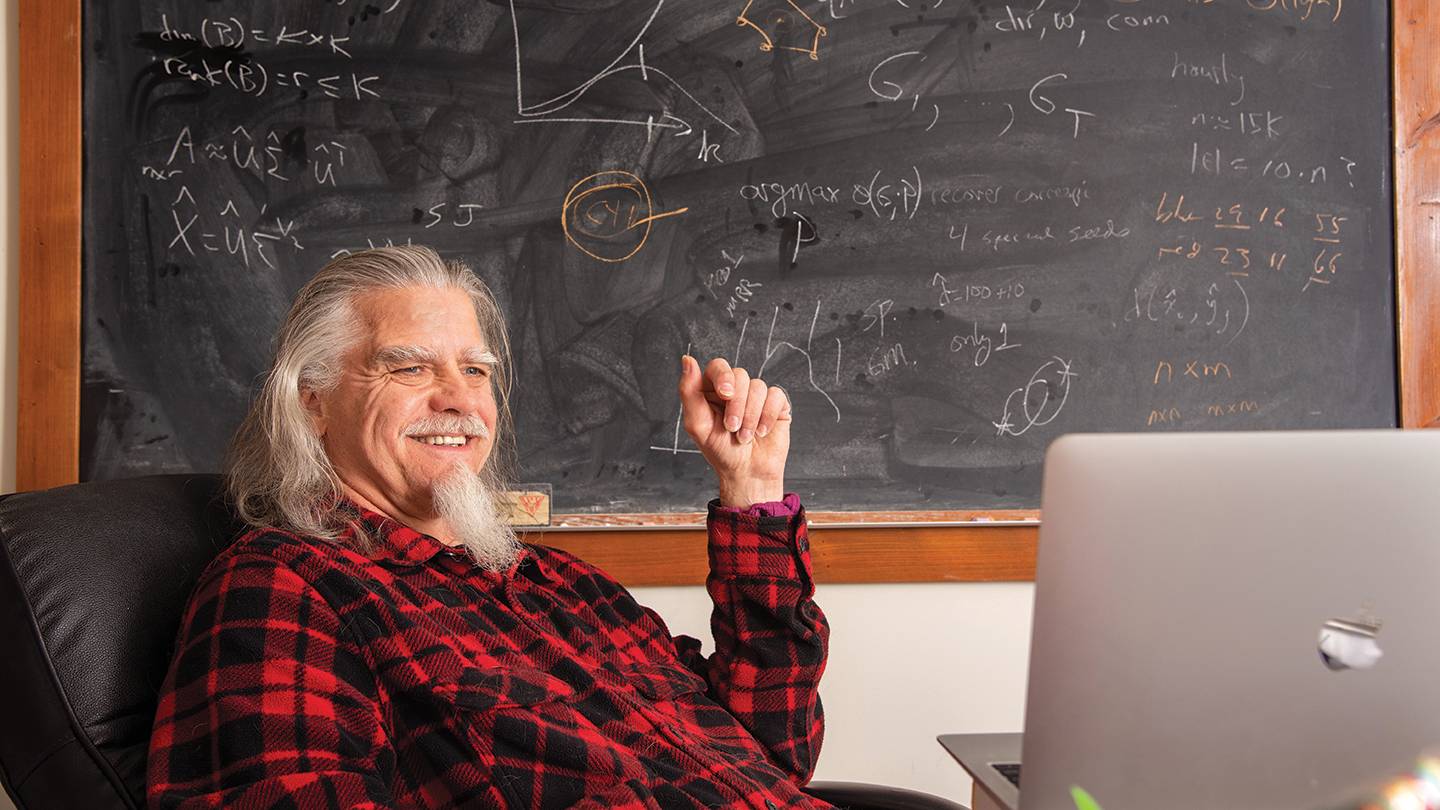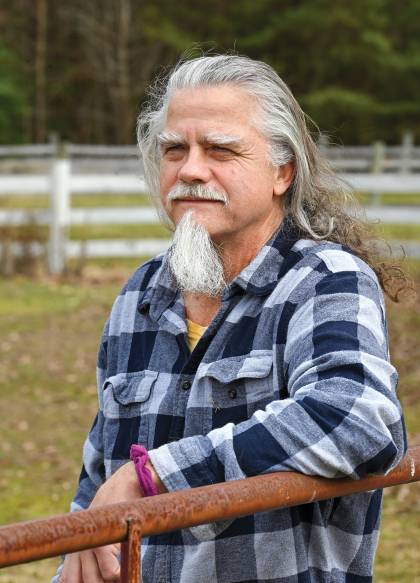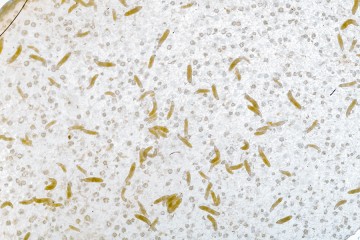Carey Priebe has worked with hospitals hoping to reduce stress on surgical nurses, cancer researchers trying to improve mammograms, and neuroscientists mapping connections between brain cells. He's shown how satellites can spot Martian volcanoes and given law enforcement new tools against human traffickers, shadowy financial networks, and corporate fraud.
The athletic, 6-foot-3 professor of applied mathematics and statistics at the Whiting School of Engineering, with his calm midwestern manner, graying ponytail, and white goatee, claims no expertise in any of these fields. But he has helped professionals in all of them.
His specialty is analyzing networks—of people, neurons, organizations, you name it—using statistics and graph theory, a mathematical discipline that reduces problems to the study of points and the lines that connect them.
Graph theory dates back to the 18th century and for a long time had limited practical application. In today's wired world, this highly abstract mathematics has become a powerful tool for defining, predicting, and comparing all kinds of things. The theory has aided the development of machine learning and artificial intelligence, which have driven the rise of tech giants like Facebook and Google.
While Priebe is just one of many working in his field, colleagues and former students say his work stands out for its rigorous theoretical approach to solving real-world problems.
He has published in Science and Nature, and held fellowships at the Alan Turing Institute in London and the Isaac Newton Institute for Mathematical Sciences at Cambridge. He has received funding from the National Science Foundation, the National Institutes of Health, the Defense Advanced Research Projects Agency, and Microsoft, and has worked with the Johns Hopkins University Applied Physics Laboratory on cyber issues as well as with a team at Cambridge University on understanding the wiring of the brain.
Although he is a mathematical statistician, he says he doesn't generally work with numbers. He has a doctorate in information technology and computational statistics, but he mostly leaves the heavy-duty work of writing computer programs to others. Statistical problems are expressed in formulas, but he doesn't spend a lot of time writing them either. Why should he? He knows the answers to many statistical questions without solving them formally.
He's won teaching awards but says he mostly instructs by example.
"It's hard to explain and hard to impart to students what I do, other than letting them sit around and watch how I do things and see how I pick problems," he says. "In a place like Hopkins, a research university, really choosing good problems is the important thing."
Several of Priebe's former students, a number of whom have gone on to prestigious jobs in industry and academia, said he is a creative and meticulous scientist.
Christopher White, who received his PhD in electrical engineering from Johns Hopkins in 2009 and now leads a team of scientists at Microsoft, says four of his 2020 summer interns are tasked with extending Priebe's work in fields including cybersecurity, search engines, and organizational management.
"Really what Carey has done, he has built a body of work creating approaches to solving very important problems to government and to corporations, and he's done it in a way that's rigorous mathematically," says White, who has funded some of Priebe's research. "He really cares about whether the work is rigorous and reproducible and relevant."
Glen Coppersmith, who has a doctorate in experimental psychology and a master's in psycholinguistics, worked with Priebe starting in 2004 while a graduate student at Northeastern University and moved to Baltimore to work with Priebe at Johns Hopkins four years later. The two still collaborate.
"He has this sort of beautiful way of looking at problems that seem very different and finding a common path to their solution," says Coppersmith, who owns a company that analyzes psychological and behavioral data. "He would come up with these great theories, and I would test them out in the real world. I'm still surprised by the problems he can come up with."

Image credit: Mike Ciesielski for Johns Hopkins University
During a visit to his hometown in Iowa years ago, Priebe tried to explain to his grandfather what he did for a living. At the time, he was analyzing satellite images to help spot extinct Martian volcanoes.
"Volcanoes on Mars?" his skeptical grandfather asked. "Your brother works in a meat-packing plant. When are you going to get a real job?"
Tackling the hard stuff
Priebe was born and raised in the farming town of Lone Rock, Iowa, current population 141, where his grandfather owned Priebe's Modern Market and Super Service Station, the only grocery and gas station in town. As a self-described jock in high school, Priebe dreamed of a career in the NFL.
After arriving at West Point and trying out for the football team, he was made the seventh-string tight end. With little chance of playing in a college game, much less the NFL, he concentrated on math and after two years transferred to Purdue on scholarship. Later, he was hired by a Navy research and development lab in San Diego, which paid for graduate school. At the time, the Navy paid the tuition for computer science-related studies, but not for math—which is how he wound up with a doctorate in computational statistics.
"I remember driving around with my brother saying that computer science is just too easy, math is hard, so that's what I'm going to do."
Priebe says he was afraid he wouldn't be good enough for Johns Hopkins before arriving in 1994 to join the faculty as an assistant professor in the Department of Applied Mathematics and Statistics. Johns Hopkins is revered in Lone Rock because when his grandmother sought treatment for cancer at Mayo Clinic long ago, doctors there referred her to Johns Hopkins.
She never made the trip to Baltimore, maybe because of the discouraging prognosis, and died of her illness before he was born. But Priebe says many in Lone Rock still hold the institution in high regard.
Johns Hopkins is still thought of as the place where Mayo Clinic refers difficult cases, he says, "and Mayo Clinic is where God goes for checkups."
The Enron emails
One of Priebe's major projects began in 2004, when a database of 600,000 emails exchanged by the executives of Enron, the giant energy trading company that collapsed in 2001, was made available to the public.
Investors lost $74 billion in what at the time was the largest corporate bankruptcy in U.S. history, and Enron became a symbol of corruption and accounting fraud.
Scientists suspected they could use algorithms to learn a lot about how an organization operated from the pattern of email exchanges and the words used in those messages. Previously, there was no mammoth, real-life archive of email traffic available for study. The Enron scandal provided one.
Priebe worked with Johns Hopkins research scientist Youngser Park and two scientists at military research and development labs to map the pattern of communications among employees to flag "potentially informative events" as the company unraveled in the spring of 2001.
The team discovered that over a period of one week in May, seven months before the company's collapse, the pattern of Enron emails altered. Overall traffic decreased, high-ranking executives began sending email through the accounts of subordinates, and some employees switched email addresses, suggesting something was up.
The work made waves: The New York Times published an infographic of Priebe's data as part of a May 2005 story on the company. In a paper presented at a conference a few months later, he and his co-authors wrote that the May 2001 event may have been linked to an insider trade executed around the same time.

Image credit: Mike Ciesielski for Johns Hopkins University
Prosecutors later asked Priebe to appear as an expert witness in the Enron trial, but he makes a practice of turning down such offers and declined. Enron's two top executives were eventually convicted of securities and wire fraud and sentenced to prison.
Tracking the traffickers
In the early 2010s, Christopher White, then a program manager with DARPA, was working with the military in Afghanistan on efforts to use data in the fight against insurgents. He called Priebe to ask if he could use his statistical skills to track the flow of money through insurgent organizations.
That work was so successful, White says, that Priebe's approach was later adapted for use by the U.S. Treasury to help identify and target international money laundering networks.
Later, White and his team began to study ways to disrupt sex trafficking, a major part of the $150 billion-a-year global human trafficking industry. Over a two-year period beginning around 2013, they gathered 60 million online ads, chats, forums, and solicitations for sex services worldwide.
As part of the project, White asked Priebe and a Johns Hopkins team to write an algorithm to automatically search 31,000 ads for sex services, try to identify suspected trafficking groups hidden in the data, and rank those groups by size, on the theory that the bigger operations were more organized and important.
In a 2015 paper in Annals of Applied Statistics, Priebe's team described how their algorithm scoured the ads for matching phone numbers and return addresses, and sorted them into separate groups. They came up with a list of the largest suspected traffickers, flagging them for possible follow-up by on-the-ground investigators.
Thanks to the work of Priebe's team and others, White says, the New York District Attorney's office has increased sex trafficking prosecutions over the past few years from about 30 cases a year to 300. He said prosecutors have used the data to pursue larger cases, including against international traffickers.
Dancing flies
While Priebe was working on the anti-trafficking project, he and Johns Hopkins neuroscientist Joshua Vogelstein, another of his former students, were asked to lend their expertise to one of neuroscience's biggest questions: How do patterns of activities in neurons generate behavior?
A research team then at the Howard Hughes Medical Institute pinpointed 200 or so neurons controlling learning and memory in the brain of the fruit fly larva, and inserted genes in those neurons that caused them to fire when exposed to light. Their aim was to link specific neurons with the movements they help trigger.
A high-resolution video camera recorded the responses of 37,780 flies to flashes of light, but sorting the resulting twists, turns, and twitches into distinct, coherent categories was a huge challenge. So the Hughes team, led by Marta Zlatic and Albert Cardona, turned to Priebe, Vogelstein, and Park at Johns Hopkins for help.
The scientists devised an algorithm that sorted the larvae's videotaped movements into three general categories and 29 specific behaviors—including hunching, wiggling, and turning in a circle. When the Johns Hopkins-Hughes work was published in Science in 2014, it made headlines around the world. "Fly Brain 'Atlas' Opens Door to Linking Human Neurons to Actions," Reuters announced.
Priebe, Vogelstein, and the Zlatic-Cardona lab, now at Cambridge University, published a paper in Nature in 2017 with the first fine-grained wiring diagram for the 200 learning-and-memory neurons in the larval brain. The Johns Hopkins researchers have subsequently helped produce a similar diagram of the connections between the synapses, axons, and dendrites of all 2,400 neurons in the fly larva's brain. They expect to publish the work sometime this year.
Part of the project involves matching every neuron in one hemisphere of the larval brain with its twin in the other. Most fly larva brain cells are thought to have a twin; matching them could help answer questions such as how much natural variation occurs between the left and right hemispheres. But until recently, the pair matching had to be done by hand, and progress was slow. So Priebe and Vogelstein searched for a shortcut.
They decided to use an open-source computer program to produce a rough list of potential matches and then filter the results through a neuron-matching algorithm they developed. Early tests have been promising. Priebe says the technique could cut the time required for matching neurons from weeks or months to a matter of hours.
Vogelstein, an assistant professor of biomedical engineering, calls Priebe "my guru."
"When we're working together, one value that he really adds to our collaboration is I can make statements that are kind of hand-wavy, and then together we figure out how to make them really formal and precise and clear and provable," he says. "Carey is really good at making things simpler. It's relatively easy to have a complex idea that might work. It's much harder to have a simple idea that will work."
Payback time
Today, Priebe and his wife, Terresa, have a house near the Homewood campus and a farm in northern Virginia, where they keep horses and adopt stray dogs and cats. Priebe runs marathons and rides his horses, despite breaking his back in a 2012 riding accident. After his fall, he spent one night in the hospital and six months in a brace.
While he uses email, he refuses to join Facebook, Twitter, or other social media and doesn't have a cellphone. He says he knows how easy it is to build a detailed picture of a person using their data trail.
While there is a lot of public concern about government surveillance, Priebe says he is more worried about the internet giants. "It's not hard to imagine what industry is collecting and what they might do with what they collect," he says.
Terresa Priebe runs a travel agency and leads safaris and cultural trips to Africa, among other places. She organizes annual medical missions to Tanzania, helping provide rural communities with needed medical care.
She raised their twins, Priebe says, while he worked nights and weekends to get tenure at Johns Hopkins. Now he's doing his best to make it up to her. "I've been paying her back ever since."
Priebe says he feels "a special debt of gratitude" to one of his high school teachers in particular, Rochelle Scott, who realized that he could go a lot further with math than his tiny rural high school could take him. So she bought some math books and set up tutoring sessions.
"She sort of tried to develop a calculus course for me, and she didn't know calculus either, I think, so she was learning it too," he says. He's not certain why, but somehow "she decided that maybe I should be exposed to that sort of thing."
Priebe never forgot what she did for him. After receiving his PhD, Priebe drove the seven miles from Lone Rock to her home in Burt, Iowa, population 505, and presented her with a copy.
Looking back on his career, he sounds surprised by how far he has come and how many people have helped him get there.
"I consider my life one lucky break after another."
This article originally appeared in JHU Engineering magazine.
Posted in Science+Technology
Tagged faculty, statistics, applied mathematics










